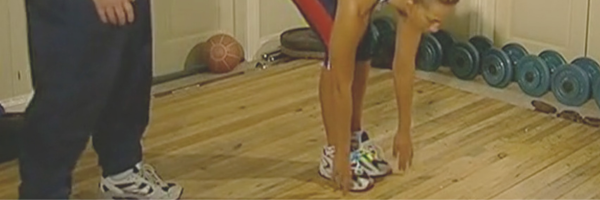Rhabdo – The New Black
Mike would not be happy
In the late 1990’s a member of the Tufts University in Boston Massachusetts reached out to me. As a result of that initial email exchange, he first attended a live seminar with me in his home city in 2000, and from there attended every professional development opportunity held in the US and some additional ones abroad. He was committed to this role, serving the athlete.
His name was Mike Pimentel. Mike’s initial qualification was as an Athletic Trainer and he worked in the Tufts Athletic Training Department for about a decade, from memory. In the 1990s he was then approached to start up and run a new department at Tufts, their ‘strength & conditioning department’.
Faced with serving the entire athletic preparation at the university of over 700, Mike was no stranger to going the extra mile for his clients. Sleeping under the desk in his office due to working late and the long drive home and back for an early start, was just one example.
Being at the coal face, Mike felt pieces were missing and was looking for the answers, looking for a better way to prevent injuries and enhance performance. That’s where I came in.
From about 2002 to 2018 I visited the university annually, providing guidance and learning more about the challenges faced.
One of the many innovations Mike put into place was a course that resulted in students with the qualifications to provide training supervision to their cohort. Mike was a pioneer in solving the challenges faced by NCAA colleges, where the demand for athlete preparation services typically exceeded the budget.
I know I speak for all the students and alumni during Mike’s 30-year contribution at Tufts that all were blessed by his presence. It may have only been a Div. 3 college, but they received first-class service.
Just six years after Mike’s passing, his beloved Tutfs was home to the latest new-age equivalent of vomiting to prove how tough the training session was – heat induced near fatal rhabdomyolysis.
So what is rhabdomyolysis?
Rhabdomyolysis is a big word for saying that training was so intense, and the body temperature was so elevated, the muscles started breaking down, releasing their content into the bloodstream, and endangering organ status in doing so.
Rhabdo is the abbreviation.
What are some other variations?
Rhadbo symptoms can appear similar to heat-related illnesses and dehydration. It’s likely that athletes training in hotter environments show extreme symptoms of heat stroke first. The only way to determine if you have rhabdo is through testing.
How dangerous is it?
According to the US Centers for Disease Control and Prevention it is “a serious medical condition that can lead to permanent disability or death.”
How common is it?
Rhabdo is fast becoming the gold standard of ‘conditioning training intensity’. Here are some other examples (this list is not exhaustive):
| Year | Institute | Sport | # affected | Timing |
| 2024 | Tufts Univ. Boston[1] | Men’s Lacrosse | 12 out of 50
(25%) confirmed [2] |
Sep 16 2024 |
| 2023 | Mid America Nazarene University in Kansas, | American Football | Pre-season football late July | |
| 2023 | US Miltiary[3] | Military training | 52 – 40.5 cases per 100,000 person-years, the highest rate observed during this study’s 2019–2023 surveillance period. | |
| 2018-2022 | Between 2018 and 2022, at least 11 football players in the US—at the student and professional level—have died of heat stroke. And the number of young athletes diagnosed with exertional heat illness has been increasing over the past decade or so…[4] [5] [6] [7] | |||
| 2020 | Manly-Warringah Rugby League Club, Sydney[8] | Rugby League | 1 death | 23 Nov 2020; First training back in the off-season |
| 2019 | Manly-Warringah Rugby League Club, Sydney [9] | Rugby League | 1 near-death | offseason conditioning |
| 2012 | Ohio State University[10] | Women’s Lacrosse | 6 athletes admitted to hospital | March[11] |
| 2011 | University of Iowa [12] | American Football | 13 athletes admitted to hospital | offseason conditioning, return from school break |
| 2010 | Oregon high school | American Football | Among 43 players, 22 (51%) experienced rhabdomyolysis; 22 patients had upper arm myalgia; 12 were hospitalized; 3 experienced triceps compartment syndrome. | an upper arm exercise held in a non-air-conditioned wrestling room. |
Conclusion
There was a time when getting an athlete to vomit during ‘conditioning’ training was a sign of how ‘tough’ the session was, perhaps a badge of honour for the trainer. Not that I agree with this approach but it cannot be denied as a phenomenon. Now it appears the stakes have been raised. Vomiting is not good enough. Near-death or death appears to be the new gold standard in ‘that was a tough workout.
That’s not encouraging. It’s insane, but is it going to turn around? Based on the lack of accountability I see in the official who ran the programs highlighted above, I suspect the answer is no. It is going to get worse.
What you and I can do, if you share my thoughts on this, is to ensure that no such situation or outcome occurs on our watch.
We are here for the athlete, and I cannot see now near-death or actual death experiences from off-season conditioning training is serving the athletes.
On its surface, a statement such as this should be redundant. But it isn’t, considering the trend.
I believe Mike would not be happy about the event that occurred at his beloved alma mater in 2024. And no one who puts the athlete first should be happy with this new ‘training trend’.
References
[1] https://www.usatoday.com/story/sports/2024/09/23/tufts-university-lacrosse-players-rhabdo-training/75347715007/
[2] https://www.nbcboston.com/news/local/tufts-mens-lacrosse-players-hospitalized-following-workout-led-by-graduate-of-navy-seal-training-program/3494987/
[3] https://pmc.ncbi.nlm.nih.gov/articles/PMC11107841/ The 529 reported incident cases of exertional rhabdomyolysis among active component U.S. service members in 2023 represent an unadjusted annual incidence rate of 40.5 cases per 100,000 person-years, the highest rate observed during this study’s 2019–2023 surveillance period. This increase in crude incidence rates was most noticeable in the Marine Corps,
[4] https://www.motherjones.com/environment/2023/09/football-players-deaths-excessive-heat-coaching/
[5] https://www.theguardian.com/world/2023/sep/24/football-player-heat-deaths-athlete
[6] https://www.usatoday.com/story/news/nation/2024/09/21/heat-kills-student-athletes-how-schools-can-help/74843984007/
[7] https://www.theguardian.com/sport/article/2024/aug/23/high-school-football-deaths-heat-stroke
[8] https://www.theguardian.com/sport/article/2024/may/03/nrl-player-keith-titmuss-died-after-inappropriate-training-session-coroner-finds
[9] https://www.foxsports.com.au/nrl/nrl-premiership/nrl-2024-former-prop-lloyd-perrett-launching-legal-action-against-sea-eagles-heat-stroke-keith-titmuss-news-videos-highlights/news-story/f444cc32ea5ef9d968a7d5b899af09c8
[10] https://www.dispatch.com/story/lifestyle/health-fitness/2013/03/09/rhabdomyolysis-laid-low-6-athletes/23706206007/
[11] “In the Ohio State case, Kelly Becker told university officials that on March 6, 2012, the women lacrosse players performed a series of grueling upper-body workouts unlike anything they had done to that point in the season. The workout included pull-ups (she did 56), chin-ups and triceps-crunching dips without rest during a 20-minute workout. Two days later, they pushed football blocking sleds. The six players went to the hospital the next day.”
[12] https://www.espn.com/college-football/news/story?id=6061650




